There is no doubt Milford Sound has spectacularly dramatic landscapes that are hard to miss, but you may not know about the masses of wildlife species that live in different ecological niches throughout the area, in among the rainforest, between the rocks, and below the surface.
Rare, endangered, and outright charismatic critters all call this fiord home and spotting the wildlife living in their natural habitat is a huge part of the experience. Here are just a handful of the animals and marine life living in Milford Sound that you might see on your next visit.
In the Rainforest
New Zealand’s diverse wildlife rests atop the wings of our beautiful birds of which we’re known for. As New Zealand birdlife lacked native natural predators for so long, many of our well known bird species live on the forest floor and under the rainforest canopy alongside other crawling critters.
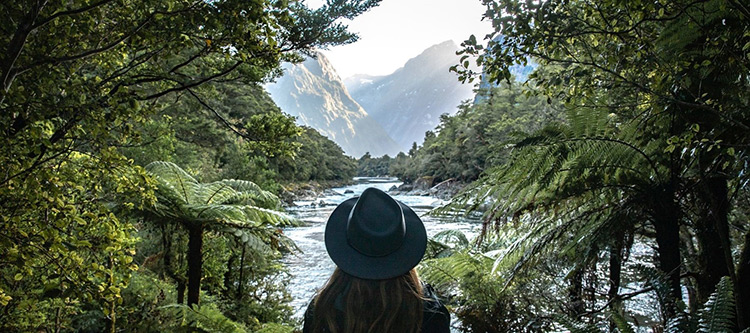
Kea
If you catch a gorgeous flash of green and orange feathers soaring overhead, or notice some mischief – mishaps at your vehicle or camp, you’ve found the Kea! Kea are only found in the South Island of New Zealand and wander around many different areas of the forest. They are also the world’s only alpine parrot; they love to rise above the tree line and live in mountainous environments.These cheeky birds are often found on the road to Milford Sound, scoping out their next meal around tourist lookouts. Kea are very curious and will have no problem flying off with your keys, passwords, money, and basically anything they can get their beaks on.
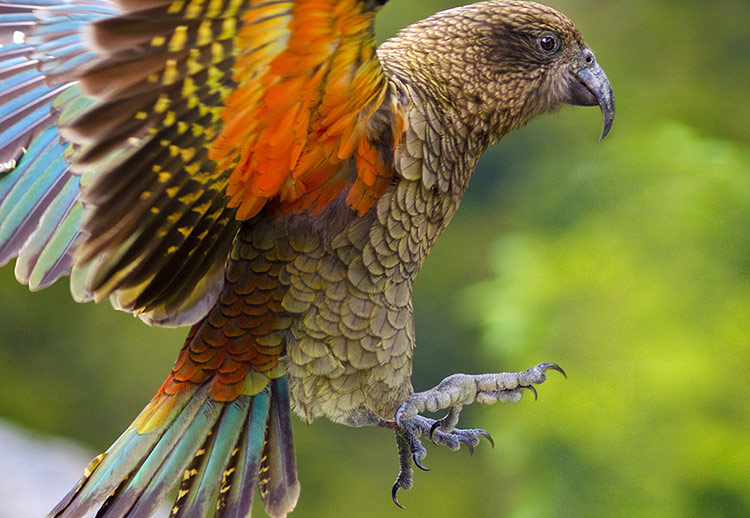
Tūī
Unlike Kea, the only place that Tūī are not commonly found in New Zealand is high up in the Southern Alps. In most other areas of the country, these birds are reliable companions in our forests. Preferring lush New Zealand bush, you’ll find these songbirds at lower altitudes in the treetops of Milford Sound. You’ll likely hear their unique songs before you see them, but once they emerge you can recognise Tūī by the white neck tufts and a blend of blue and green feathers that are strikingly colourful in the sunlight.
Mohua/ yellowhead
Once living in abundance throughout New Zealand, the small population of Mohua/ yellowhead in Fiordland is now only one of the four population groups of these birds. You’ll have to keep an eye out for these ones as they’re small in size, but their vivid colouring should give you a hint. If you’re keeping your traveller wallet well stocked, you may recognise the Mohua/ yellowhead from New Zealand’s $100 note!
Whio/ Blue Duck
If you see a Whio, or referred to as ‘ko whio whio’ in the South Island, you are having a very lucky day; these tough and adaptable ducks are rarer than some species of Kiwi. They stand out from other ducks due to their gorgeous deep blue feathers, blending in with the waters around them. They thrive under forest canopies and are one of the only ducks in the world to live in fast-flowing rivers. As they’re prone to isolation and need healthy rivers to survive, it’s no wonder that the Whio dwells in the untouched beauty of Milford Sound.
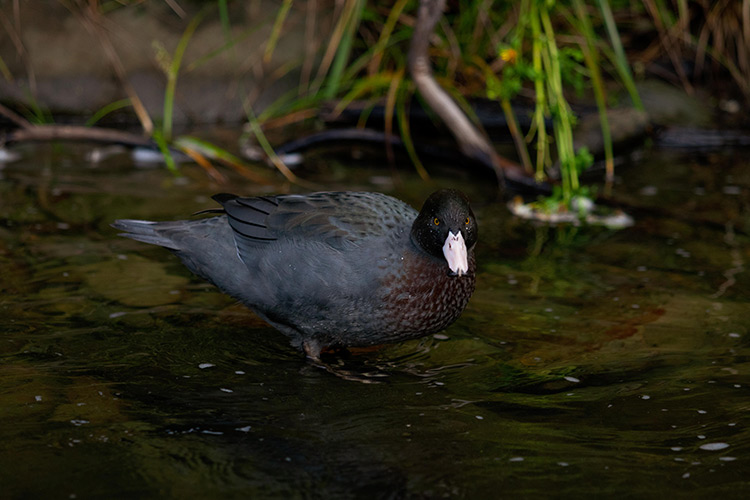
Best way to see rainforest birds and wildlife: Choose a full-day trip to Milford Sound which includes transport on our comfortable coach. This gives you a better chance at spotting tree-loving bird species from the window and at the designated rest stops.
The Rocky Shores
There are many species of sea life that are known to take a break and bask in the sun on the rocky shores of Milford Sound.
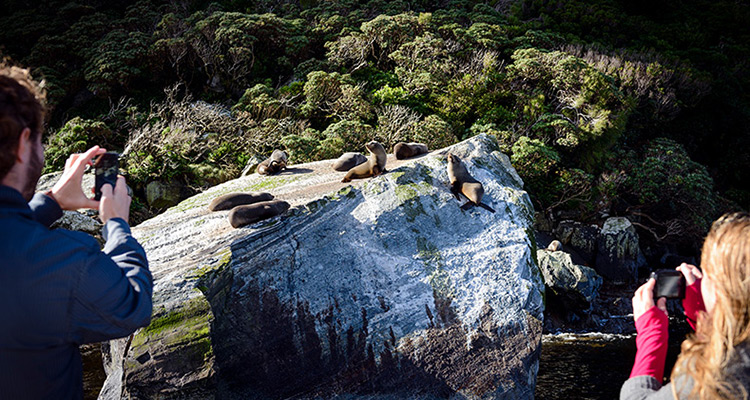
Kekeno/ New Zealand Fur Seals at Seal Rock
There are few wild animals you can observe that are as seemingly relaxed as New Zealand Fur Seals (also known as Antarctic fur seals) sunbathing; they fit right into the Kiwi culture! There is a high chance you’ll spot fur seals relaxing on Seal Rock as colonies of these flippered friends live in Milford Sound year-round.
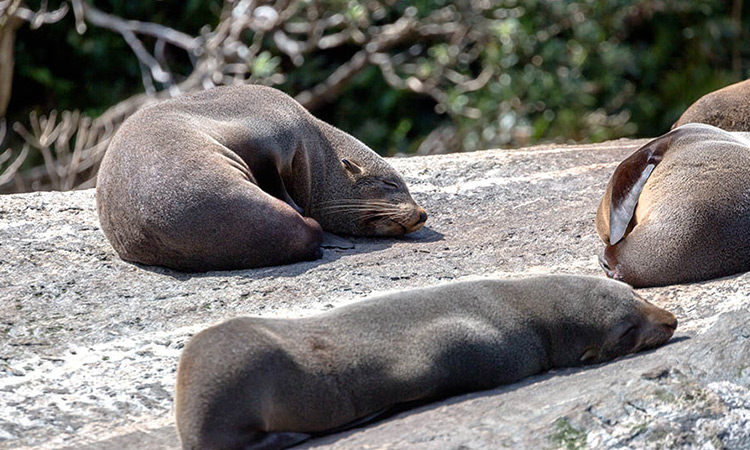
Tawaki/ Fiordland Crested Penguin
The Tawaki are easily recognisable by their bright orange beak and their crown of golden blonde feathers. These penguins are pretty special; they’re an endangered species, one of the rarest penguins in the world, and are only found in the South-Western South Island and Stewart Island.
When they’re not spending 75% of their time in the water when hunting or migrating, they settle on the West Coast shores for breeding season; they’re breeding season is from July-November and creates the best time to see them in Milford Sound. As this species often returns to the same breeding ground year after year, you may be able to come back to watch the same colony grow older!
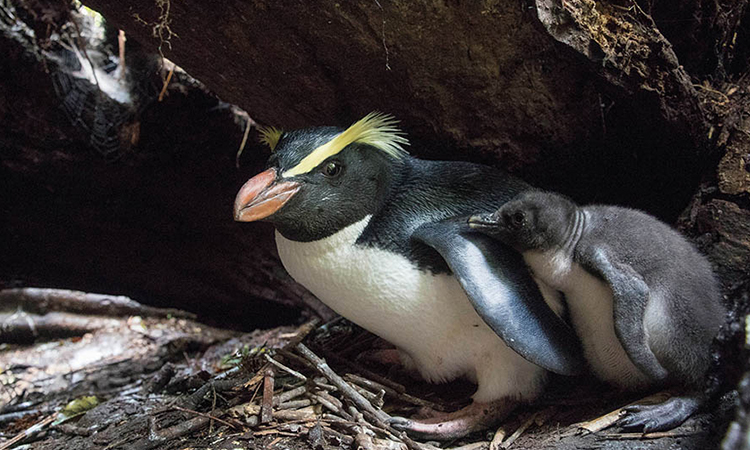
Kororā/ Little Blue Penguin
Although the Little Blue Penguin is a more common species of penguin, that doens’t meant that seeing them at Milford Sound is any less exciting! You’ll need to bring your sharpest eyesight though, as you’ll be trying to spot the smallest penguin species in the world who are equipped with the perfect grey-blue colouring to melt into their rocky surroundings.
Albatross
Seeing an albatross, the world’s largest flying seabird, spread its wings and soar above their salty seawater habitats is an impressive thing to witness. There are thirteen different varieties of albatross known to breed in New Zealand, more than anywhere else in the world. Such powerful and imposing birds flying through an almost prehistoric landscape like Milford Sound makes for a memorable and grand sight.
Best way to see these species bathing on the rocks: Take a lap of the shoreline and cut through the fiord on the Nature Cruise or Discover More Cruise.
The Underwater World
Milford Sound is home to the Piopiotahi Marine Reserve, a haven for marine ecosystems that spans almost 700 hectares until the fiord meets the Tasman Sea. This sanctuary is one of ten in Fiordland and contributes to Milford Sound’s reputation for incredible ocean encounters.
Bottlenose Dolphins
There are around 60 Bottlenose Dolphin braving the temperatures and living in the waters of Milford Sound. This species of dolphin, known for their short beak and larger forehead area, won’t venture further South in the hemisphere given their preference for warmer waters. The pod that inhabits Milford Sound is known to enjoy riding the waves of our cruises and occasionally break the surface with a jump. Keep your cameras at the ready!
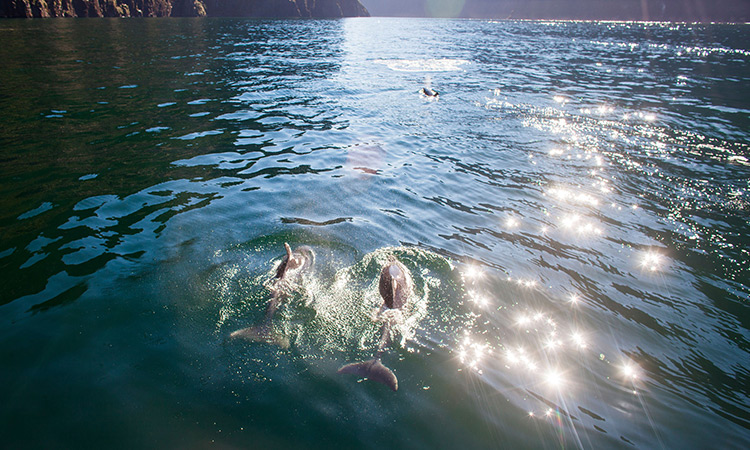
Hector’s Dolphin
Hector’s Dolphin is a beautiful and slightly adorable dolphin species. Its small size (the smallest dolphin in the world), unique markings that seamlessly blend from black to light grey, and crescent shaped dorsal fin make sightings a true treat for visitors. Unlike the Bottlenose Dolphins, Hector’s Dolphins only visit Milford Sound and they’re small numbers make it somewhat rare to spot the species.
Tohorā/ Southern Right Whales
Whales are the slow yet mighty giants of the sea and we are lucky enough to have Tohorā visit Milford Sound occasionally. As their feeding patterns bring them close to shorelines and being a native migrant species to New Zealand, spotting a Southern Right Whale in Milford Sound is a possibility! These majestic whales can grow up to 18 metres long and can be known to wave hello with a flick of their large tales.
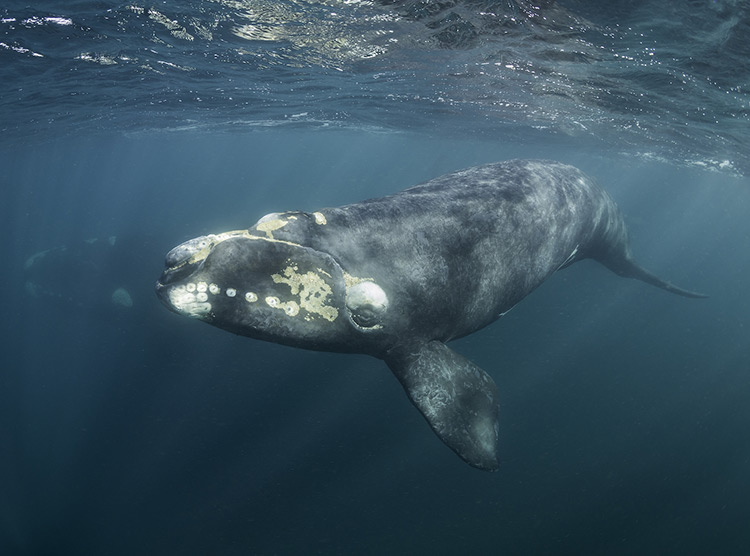
Seven Gill Shark
While a Seven Gill Shark isn’t exactly the kind of ocean encounter you can expect on a nature cruise, scuba diving or exploring the Underwater Observatory in Milford Sound may bring you face to face with these predators. Older sharks are known to dwell in deep offshore environments while most hang around channels and deeper estuaries.
Fiordland Brotula
Discovered for the first time in 1993, the Fiordland Brotula is a fish that lives only in Milford Sound. The species is fairly elusive and hard to spot, especially since they grow to only 22cm and often hide in caves, crevices, and under rocks. If the Brotula is feeling social, you may spot these from the Underwater Observatory.
Blue Cod, Butterfly Perch, Scorpion Fish, and Common triplefin fish are also commonly seen in the waters of Milford Sound.
Best place to spot these majestic creatures: The Discover More cruise allows you to see any of these species that may pop to the surface, while also including a trip to the Underwater Observatory to explore below the surface. If you’d like a more front row seat to any ocean visitors, a kayak tour makes for a truly immersive experience if luck is on your side.
The Fiord’s Deep Waters
Milford Sound is home to a whole new world of starfish, sponges, snake stars and various coral, all living in the protected ecosystem of the Piopiotahi Marine Reserve. Incredibly, these waters are home to some species normally found in deep-sea environments. This is because of a phenomenon known as ‘deep-water emergence’ that occurs where freshwater meets seawater, allowing deep-sea species to survive in much shallower environments.
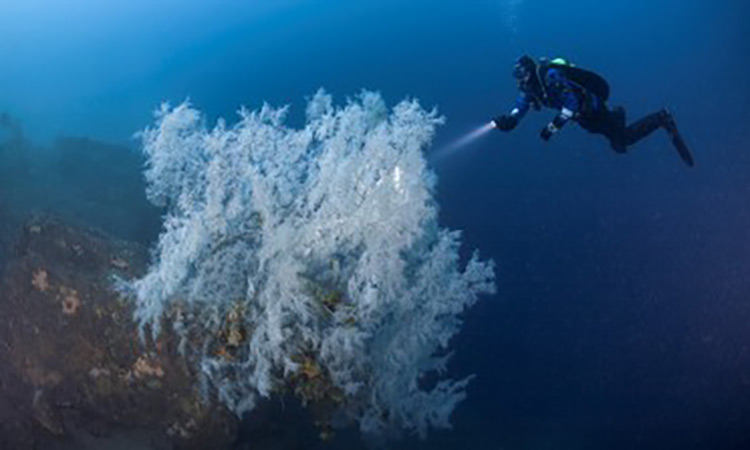
Black Coral
Black Coral is usually a deep-sea coral but lives in Milford Sound at just 10 metres below the surface due to deep-water emergence. At odds with its name, the coral is often white with only the dead sections of coral turning black due to the black skeleton. The coral is a highlight for divers and Underwater Observatory explorers with a keen eye.
Wavyline Perch
This fish is the only deep-water fish known to live in the fiords. They normally live around rocky reefs at 150-400 metres, but in the southern fiords they can be found at depths of 6–31 metres due to deep-water emergence.
Best place to view the deep water species of Milford Sound: A trip to the Underwater Observatory ten metres below the surface is the perfect vantage point to explore the depths of Milford Sound.
Nocturnal Wonders
Under the cover of darkness, there is still more to see as New Zealand’s beloved nocturnal animals wake up and the forest begins to come alive once again.
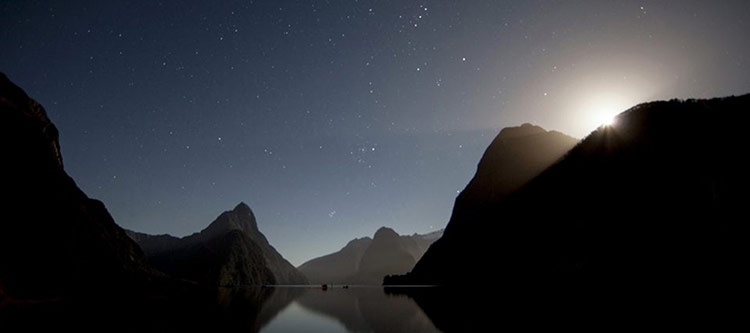
Ruru/ Morepork
The Ruru’s call is often heard in the dark nights of remote New Zealand but the small forest-dwelling owl is rarely seen by humans or its predators. Apart from hunting, it burrows its brown camouflage feathers and large yellow eyes among thick vegetation. If you’re spending a night out in the New Zealand bush, you may be lucky enough to hear a rustle and spot the elusive native Ruru in its prime.
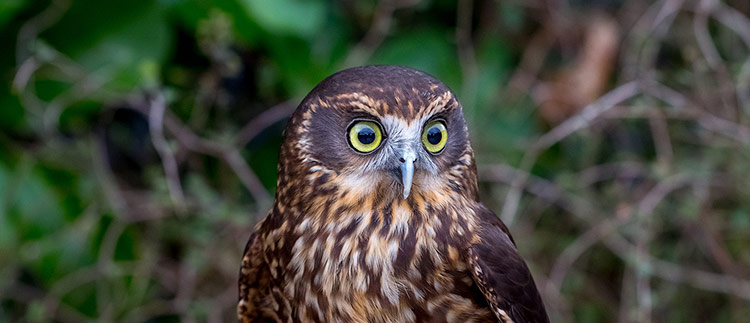
Glowworms
For larvae, the New Zealand glow worms offer a surprising and stunning bioluminescence display that light up the forests across the country. Looking for glow worms on a camping or hiking trip is a common memory for most Kiwis! Stay a night at the Milford Sound Lodge and ask your team about the best local glowworm locations.
Kiwi
The Kiwi is one of our most well known animals; New Zealand’s cherished national icon. The Kiwi is a small flightless bird covered in soft, brown, hair-like feathers and a long, slender beak. The Tokoeka Kiwi inhabits Fiordland but the elusive and rare nature of Kiwis may make it a challenge to find these curious critters on your own.

Best chance to spot nocturnal animals in Milford Sound: A stay overnight at Milford Sound Lodge to explore the rainforest at night with the guidance and advice of the lodge team.
